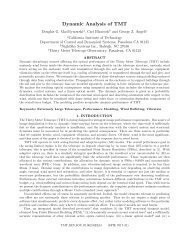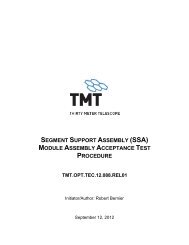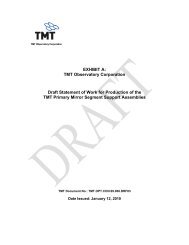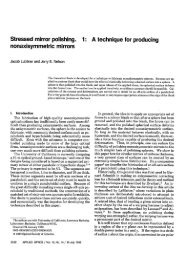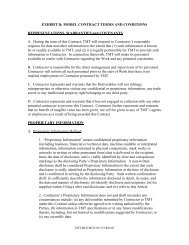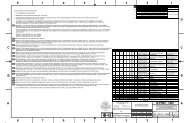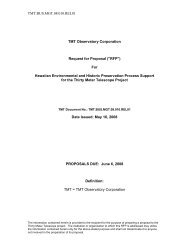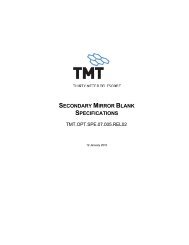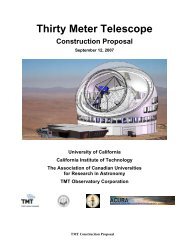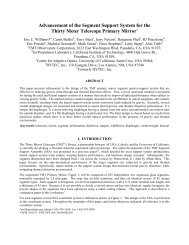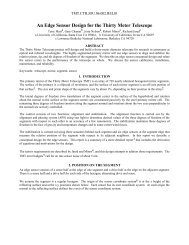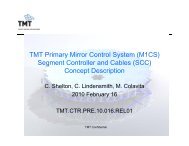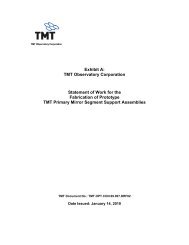THE LGSF LASER SYSTEM - Thirty Meter Telescope
THE LGSF LASER SYSTEM - Thirty Meter Telescope
THE LGSF LASER SYSTEM - Thirty Meter Telescope
Create successful ePaper yourself
Turn your PDF publications into a flip-book with our unique Google optimized e-Paper software.
TMT.AOS.DRD.09.003.DRF05 Page 15 of 30REQUIREMENTS DOCUMENT FOR <strong>THE</strong> <strong>LGSF</strong> <strong>LASER</strong> <strong>SYSTEM</strong> August 25, 2009Discussion: The NFIRAOS asterism includes six 25W LGS. A spare laser is added forredundancy. Also note that laser power is specified at the output of the Laser Head (i.e.after the output aperture of the Laser Head).[REQ-3-LAS-0320] Each individual Laser Head shall provide a coupling efficiency of atleast 130 photons-m 2 /s/W/ion (TBC) with the mesospheric sodium layer, over a period of atleast 12 hours. The coupling efficiency is based on the following parameters: a LGS beamdiameter at the altitude of the sodium layer of ~0.2m (TBC), a nominal sodium columndensity of 4x10 13 ions/m 2 , and an angle of 21 degrees (Armazones) or 40 degrees (MaunaKea) (TBC) between the direction of the laser propagation and the Earth’s magnetic field.Discussion: The total power level and coupling efficiency yield the required photon return atthe LGS wavefront sensor (WFS) for the estimated optical throughput and sodium layerparameters.Note also that 25W per beacon at this coupling efficiency is required to satisfy the first lightNFIRAOS wavefront error budget at all times, including those times with lower thanaverage sodium column density. At a minimum, a reduced power level of 17W per beaconprovides acceptable performance at a sodium column density of 3x10 13 ions/m 2 , andsatisfies the first light NFIRAOS wavefront error budget during times with median or highersodium column density.[REQ-3-LAS-0330] The Laser System shall be upgradeable to eight plus one spare (ninetotal) 25W Laser Units of the type defined in [REQ-3-LAS-0300].Discussion: The upgraded Laser System will be referenced as the final Laser System inthe rest of the document.[REQ-3-LAS-0340] The short-term (defined as a RMS variability over a 5–minutes period)power stability of each Laser Unit shall be 3% or better.[REQ-3-LAS-0350] The long-term (defined as a peak to peak variation over a 12–hoursperiod) power stability of each Laser Unit shall be 15% with a goal of 10%.3.3.2 Laser Beam Performance Requirements[REQ-3-LAS-0400] Ninety five per cent of the transmitted (far-field) laser beam energy foreach individual Laser Unit shall be contained in a 1.1 times diffraction-limited core, with agoal of 1.01.Discussion: Note that the beam performance requirement is defined at the output of theLaser Head (i.e. after the output aperture of the Laser Head).[REQ-3-LAS-0410] The laser output beams of each individual Laser Unit shall be 98%linearly polarized.Discussion: Specifications regarding the polarization direction will be defined in the nextversion of the document.[REQ-3-LAS-0420] The output beam diameter in the plane of each Laser Head outputaperture shall be 5mm ±0.3mm (TBC) at the 1/e 2 intensity points.Discussion: Specifications regarding the angular divergence of the output beams will bedefined in the next version of the document.[REQ-3-LAS-0430] The output laser beam position stability of each Laser Unit shall be asfollows:- Bias pointing accuracy between high and low power beams: ≤ 25 µrad (TBC) (Peakto peak variation),- Pointing jitter: ≤ 3 µrad RMS (TBC),- Long term drift: ≤ 100 µrad (TBC) (Peak to peak variation defined over a 12-hoursperiod),



